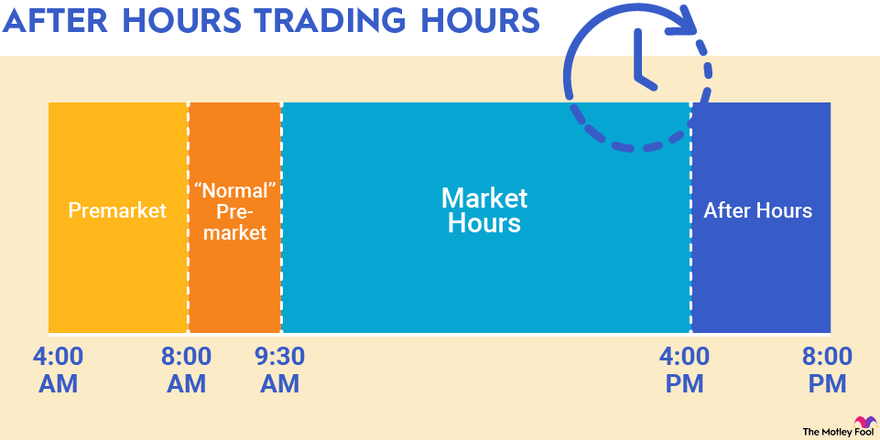Exploring After-Hours Trading: Top 5 Post-Market Performers

When navigating the intricacies of financial markets, understanding the dynamics of after hours trading becomes paramount. This concept has been steadily growing in popularity among a diverse spectrum of investors, spanning from institutions to individual traders.
After-hours trading essentially extends the traditional trading hours, enabling the buying and selling of stocks beyond the regular market schedule.
This unique approach empowers investors to promptly respond to noteworthy developments, be it breaking news or corporate earnings reports, events that frequently unfold outside the confines of standard trading hours.
In this ever-evolving financial landscape, comprehending the nuances of after-hours trading provides a valuable edge for those seeking to make informed and timely investment decisions.
Understanding After-Hours Trading
After-hours trading, often referred to as extended-hours trading, involves the trading of securities beyond the regular operating hours of a stock exchange. In the United States, standard stock market hours span from 9:30 a.m. to 4:00 p.m. Eastern Time.
However, after-hours trading extends this time frame, typically ranging from 4:00 p.m. to 8:00 p.m. Eastern Time.
This extension provides traders with an additional opportunity to engage in buying and selling activities, reacting to market developments even when the traditional market is closed.

In the past, after-hours trading was predominantly the domain of institutional investors and individuals with substantial wealth. Yet, the winds of change have blown through the financial landscape with significant force.
The once exclusive realm of institutional investors and high-net-worth individuals has now become accessible to everyday investors. With the barriers lowered, average investors can participate in trading activities during the extended hours, breaking free from the constraints of traditional market hours.
The newfound accessibility of after-hours trading stands as a shining example of how technology can bridge the gap and give more individuals the tools to participate in the market.
Thanks to this equal footing, everyday investors can now join in, placing orders and making trades even during those extended trading hours, a privilege that was once the domain of the financial elite.
The Mechanism of After-Hours Trading
The execution of trades during after-hours differs slightly from that of conventional trading hours. Instead of routing your order through the exchange, it is directed to an electronic communication network (ECN). The ECN matches buy and sell orders based on their limit prices.
Participating in after-hours trading involves a simple procedure. Begin by logging into your brokerage account and selecting the stock you intend to buy or sell. Subsequently, place a limit order, following a process akin to a regular trading session.
The order is subsequently relayed by the broker to the ECN it uses for after-hours trading. The ECN endeavors to match the order with a corresponding buy or sell order on the network.
It’s important to note that most brokerages only permit the use of limit orders during after-hours trading.
Moreover, after-hours orders are valid only for that particular session. If the order remains unexecuted, investors would need to place another order when the next trading day commences.
The Risks and Limitations of After-Hours Trading
While after-hours trading provides an additional avenue for investors, it does come with its share of risks and limitations.
Pricing Risk
The potential for pricing risk is heightened during after-hours trading. Since there are multiple ECNs, each used by different financial institutions for after-hours trading, investors are limited to the ECN their broker uses.
This restriction can impede price discovery, as it limits access to the best available price from multiple venues, a feature standard during normal trading hours.
Liquidity Risk
The unique aspect of after-hours trading lies in its lower trading volumes, resulting in decreased liquidity. As a result, investors might face challenges when attempting to execute their orders, primarily because there are fewer market participants involved during these times.
This situation can result in wider bid-ask spreads and an increased likelihood that orders may not get executed.
Volatility
The after-hours trading window often witnesses wild price swings in response to news releases. This volatility can make it difficult for average investors to determine suitable limit orders and to anticipate whether their orders will be executed.
Moreover, the price discovered during the after-hours session may not be the best one, as better prices could potentially be available during the regular trading session the following day.
Top 5 After-Hours Trading Gains
On October 13, 2023, these were the top after hours stock gainers:
1. Turbo Energy, S.A. (TURB):
- After-Hours Gain: 16.87%
- After hours: $1.94
- Last closing: $1.67
- Trading Volume: 18.18 million shares
- Turbo Energy, S.A. experienced a substantial after-hours gain, with its stock price increasing by 16.87%.
2. Stran & Company Inc (SWAG):
- After-Hours Gain: 15.09%
- After hours: $1.22
- Last closing: $1.09
- Trading Volume: 19.69 million shares
- Stran & Company Inc witnessed a significant after-hours gain of 15.09%.
3. NeoVolta Inc. (NEOV):
- After-Hours Gain: 12.68%
- After hours: $2.40
- Last closing: $2.20
- Trading Volume: 70.62 million shares
- NeoVolta Inc. recorded a remarkable after-hours gain of 12.68%.
4. Sentage Holdings Inc. (SNTG):
- After-Hours Gain: 11.70%
- After hours: $2.10
- Last Closing: $1.85
- Trading Volume: 5.27 million shares
- Sentage Holdings Inc. demonstrated a strong after-hours gain of 11.70%.
5. Conduit Pharmaceuticals Inc. (CDT):
- After-Hours Gain: 11.36%
- After hours: $1.96
- Last Closing: $1.77
- Trading Volume: 158.00 million shares
- Conduit Pharmaceuticals Inc. saw a significant after-hours gain of 11.36%.
These 5 top stocks experienced substantial price increases in after-hours trading, making them of interest to investors and traders looking to capitalize on these market movements.
In Conclusion
While after-hours trading provides an additional avenue for investors to react quickly to significant news outside regular trading hours, it is not without its risks. Trading in this window can expose investors to price volatility, liquidity risk, and pricing risk.
Given the distinct nature of after-hours trading, it is of paramount importance for investors to gain a comprehensive understanding of its associated risks and unique dynamics before venturing into this domain.
With prudent and informed use, after-hours trading can undoubtedly become a valuable asset in an investor’s toolkit, enhancing their ability to navigate the financial markets effectively.


